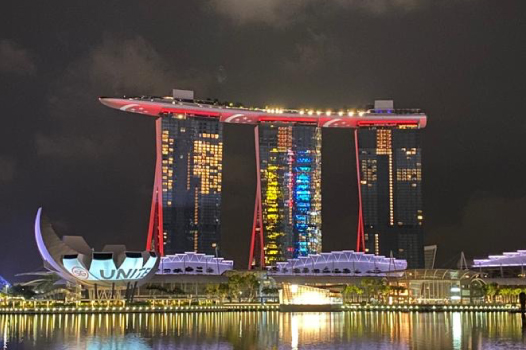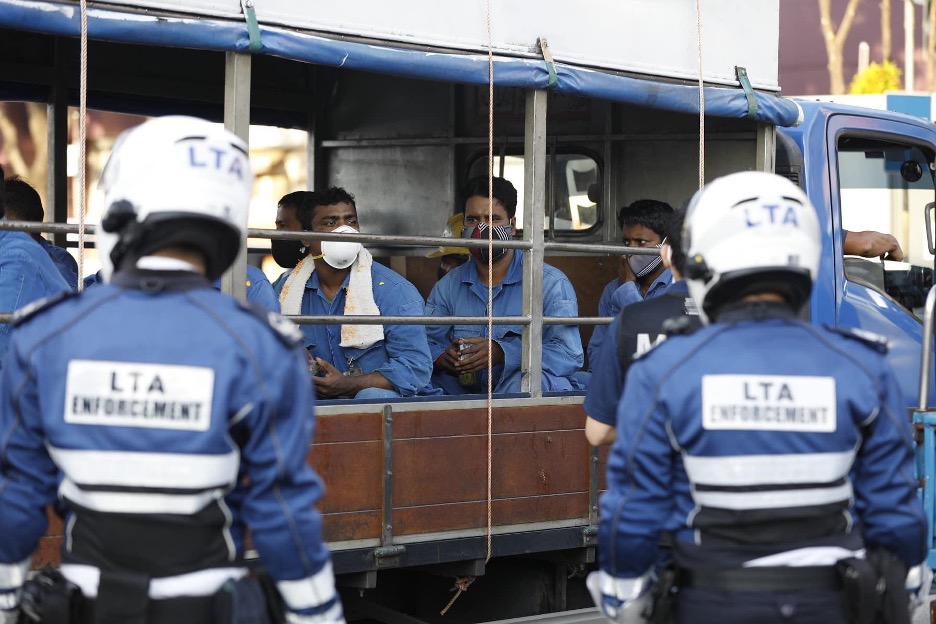On 19 June 2020, Singapore entered the second phase of its exit from a seven-week Circuit Breaker (CB) that began on 7 April, 2020. This phase marks the reopening of businesses, shops and restaurants. Gatherings are allowed of five persons at a time. People are still encouraged to work from home, keep up hygiene standards, while wearing a mask in public is mandatory.
Initially hailed as the gold standard in tackling COVID-19, Singapore’s medical protocols learned in the time of SARS worked well in late January and through February. The authorities even discouraged citizens from wearing masks, saying that they did not offer much protection. Yet, as of 20 June 2020, Singapore has had 41,615 COVID-19 cases, albeit with a low rate of 26 fatalities, with more recoveries in the past week than new cases (The Straits Times, 21 June 2020).
How did we fare?
With the return of Singaporeans and Permanent Residents from overseas, infection rates began climbing in late March, compelling the authorities to shut down the city. The very evening of the announcement of the CB on 7 April 2020, supermarkets were stripped bare of toilet paper, dry goods, staples, fresh greens and other goods with a long shelf life. There were long lines at wet markets. Masks and hand sterilizers were in short supply. Two weeks into the CB, infection rates started to soar. Belief in some quarters that the infections were mainly imported or perhaps not serious except for certain demographics, led to non-compliance of the CB and scuffles with enforcement agents. Popular outdoor areas where people could walk or run became crowded as people flocked to exercise. Cramped quarters, boredom, noisy neighbors, the urge for fitness, defiance or an excuse to be with others, amidst a host of other reasons drove people outdoors. Gradually, the authorities cordoned off more and more areas to reduce spaces where people could congregate.
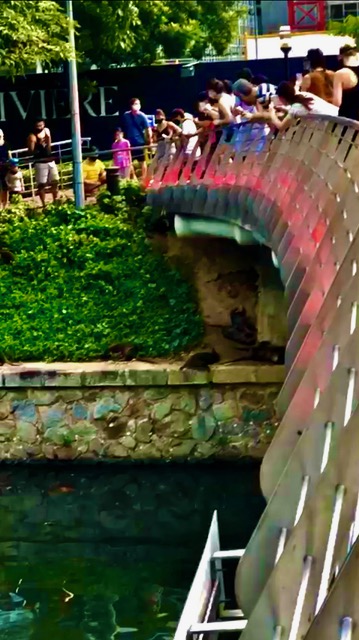
Watching otters on the riverbank, safe distancing cast to the winds! Screengrab from a video circulating on WhatsApp
Worryingly, infections were discovered among male foreign workers, a community of almost 300,000 South Asians, living in cramped dormitory quarters. Providers of essential services and invisible pillars of the city’s maintenance, these are the very people that have given their brawn, sweat and tears to build the modern city of Singapore – its glitzy buildings and A-star infrastructure of public transport, roads, bridges, airport terminals and more. Their plight got the limelight on the world stage (Ratcliffe, 2020; Stack, 2020).
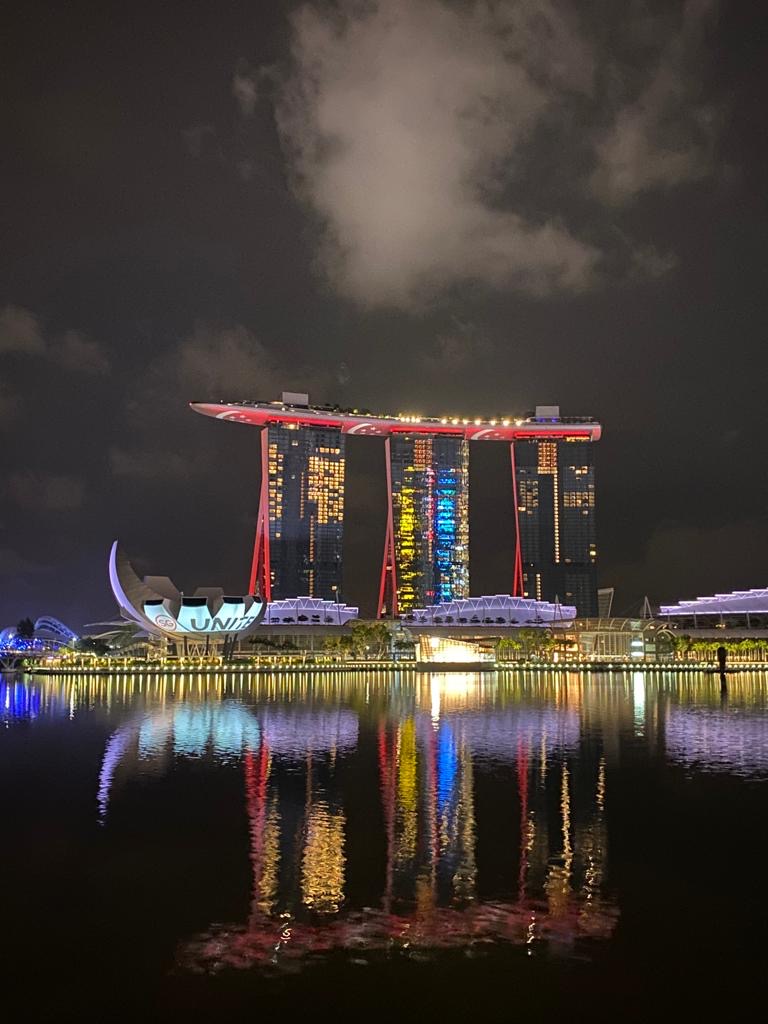
SG United – Singapore’s iconic landmarks lit up to keep spirits high. Source: Dr Hwang Yee Cheau
Just a few months earlier, these migrant workers were being heralded by the government for their role in building the nation. Now Singapore’s poor treatment of this community and neglect of their living conditions took centerstage. On 20 April, the highest number of infections on a single day, 1,396, was recorded among this group.
The authorities took immediate measures to quarantine all the workers, separating the infected from the healthy ones, and moving them into larger dormitories to allow them to maintain safe distancing. Several NGOs rallied citizens to assist in supplying meals to the workers, taking donations from the wider community to contribute to their basic needs apart from meals – phone/SIM cards for connectivity, toiletries, mobile devices. Various community organizations volunteered entertainment and other activities to keep the migrant workers busy and well cared for during their quarantine.
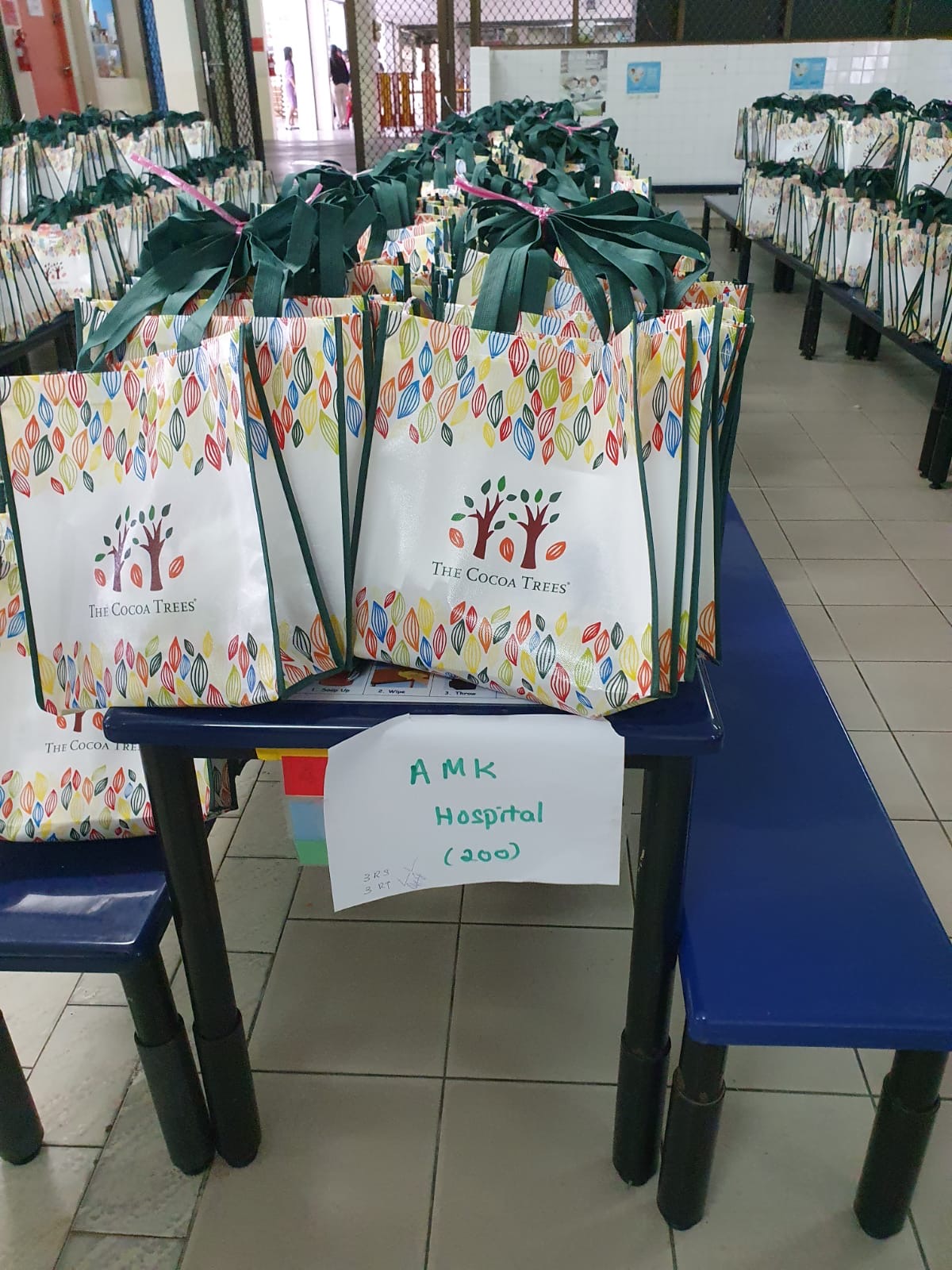
Bags of treats ready for distribution to Migrant Workers Source: Dr Hwang Yee Cheau
The government also reassured the quarantined workers that their livelihood and health would be protected. Extensive testing for infections began, with a number of private doctors, dentists and medical personnel volunteering. This has resulted in recording large numbers of daily infections, but also assisted in the containment of infections.
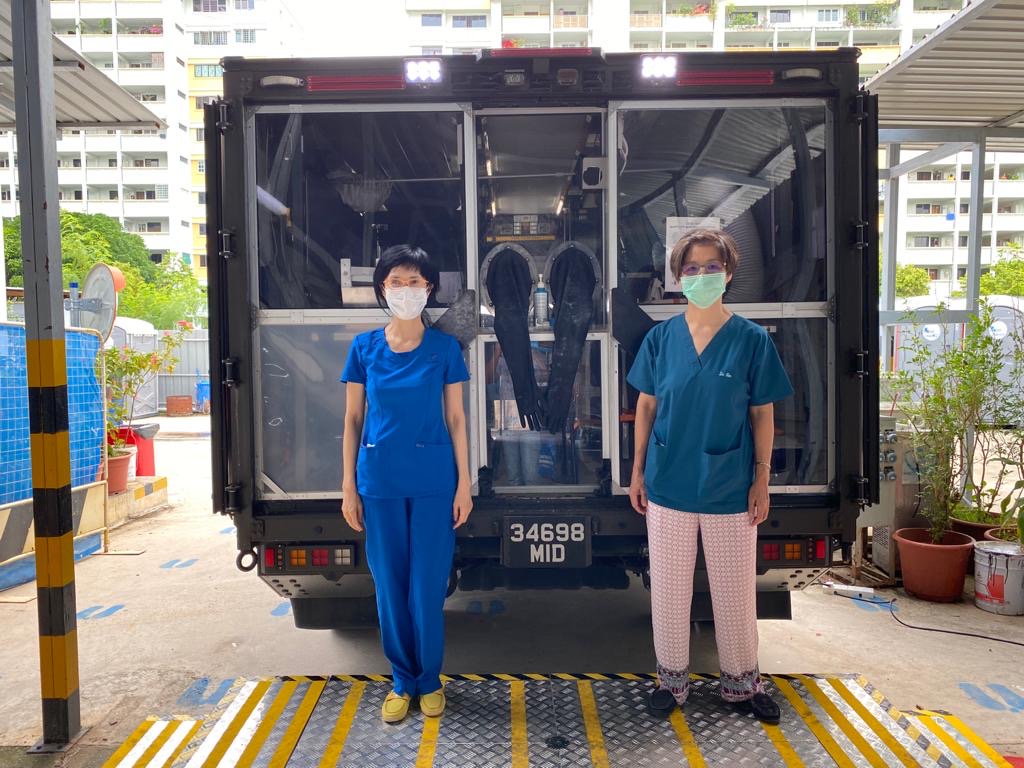
Dentist volunteers standing outside mobile test vehicle, ready for testing Migrant Workers for infections Source: Dr Hwang Yee Cheau
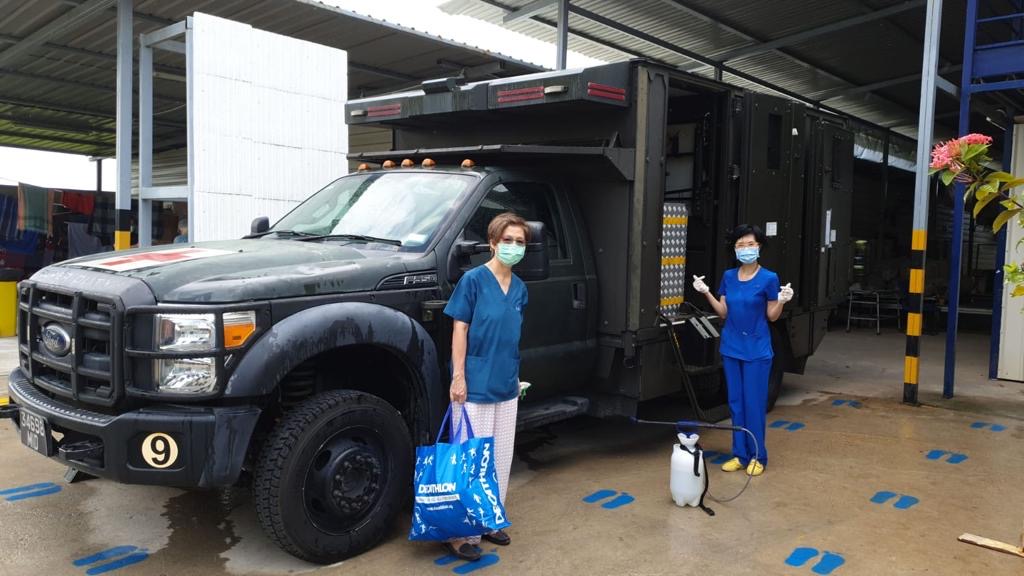
Dentist volunteers standing beside a mobile test vehicle, ready for testing Migrant Workers for infections Source: Dr Hwang Yee Cheau
Observing the Circuit Breaker — Isolation and Depression
Hype about the virus and how little is known about it has been worrisome. So most citizens have played it safe and followed the government’s directive to stay indoors. For writers, researchers, artists and creative people, to have these precious weeks to themselves to write and create may not be unique, as that is how they work daily. Nevertheless, time such as this is a great gift. In an era of peace, to have time without social obligations, and to not spend time commuting is indeed a luxury.
But is a confined private space safe for all? A worldwide increase of vulnerability to domestic violence has been reported during the COVID-19 pandemic, together with an increase in demand for services against domestic violence. Singapore is no exception recording a 22% increase in domestic violence during the Circuit Breaker (Jean Iau, 2020). Figures from the feminist action group, AWARE, bear testimony to this escalation.
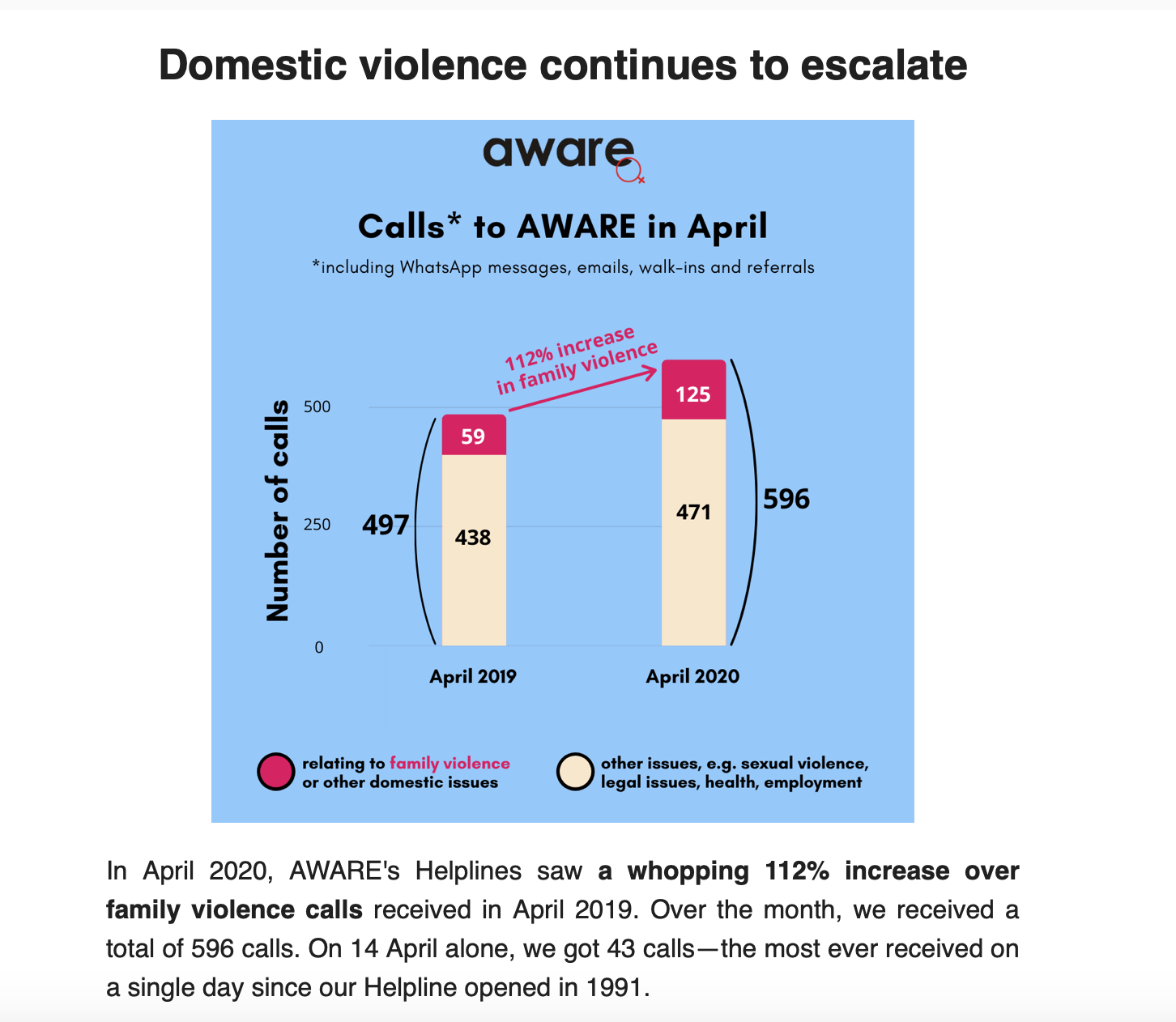
Domestic Violence continues to escalate Source: AWARE e-newsletter, 12 May, 2020
Similarly, mental health helplines have recorded a 50% uptick in the number of calls received since the outbreak. Suicide prevention hotlines experienced a 22% increase in calls. Anxiety about infection, exposure and uncertainty about the future are of primary concern (Phua & Ang, 2020). Similarly, the government helpline for seniors also recorded a 25% increase in calls. Stuck at home, seniors have been asking for assistance for the purchase of groceries, delivery of meals, collection of medicines, as well as to be accompanied on hospital visits (Tan, 2020).
Freelancers have seen their earnings plummet to zero due to closures in the entertainment, food and beverage, hospitality and art industries. A number of salaried workers working from home have suffered 20 to 50% pay cuts, severely impacting their budgets and living expenses, resulting in a great deal of insecurity. In solidarity, on 28 February 2020, the president and the entire cabinet of Singapore took a month’s pay cut, simultaneously awarding a month’s bonus salary to front line workers as well as health care workers responding to COVID-19 (Hui, 2020). On 19 June 2020, it was announced that none of Singapore’s 85,000 civil servants will receive a mid-year bonus this year. Furthermore, senior civil servants would take another half-month’s pay cut on top of the one in February (Ho, 2020a).
The Ministry of Social and Family Development (MSF) together with other agencies, has handed out monetary assistance of SGD600 (US$ 430) to all citizens in mid-April, and half that amount to Permanent Residents upon application, under the Solidarity Payment scheme (FOM, 2020). A greater sum of SGD800 (US$ 574) per month for three months was made available to the unemployed, who lost their jobs. Different packages of assistance can be applied for by the differently abled, low-income seniors, and vulnerable groups in need. Spending vouchers of SGD50 (US$ 35) are to be distributed to 400,000 households, to help households with daily spending while supporting local vendors (Goh, 2020, A4).
Businesses that employ foreign workers can also apply for assistance by way of rebates and waiver of foreign worker levies during these months. Employers are asked to pass these benefits on to their workers, in much the same way as businesses that enjoy reductions of rentals by landlords are asked to pass on the benefits from these savings to their employees (FOM, 2020).
Despite these financial measures, it is no surprise that people living on their own have felt a sense of isolation and loneliness during the CB. The inability to share anxieties and concerns has enhanced feelings of insecurity. For many, getting handouts this way in itself creates mental issues and a drop in self-esteem.
For young and fit singles, exercising outdoors and getting their takeaway meals has provided some interaction. While experts have advised people to stay connected to friends and family, keep fit, eat healthy and sleep well, people worry about the future. Will there be jobs for them after COVID-19? What sort of world will we wake up to after the CB is lifted?
For young children locked indoors to have no opportunity to play with their peers or run about in parks and playgrounds, and yet tread softly at home while their parents are working, is hard to understand. This time will surely be a defining one in their lives. Acting up and attention-seeking are issues that parents have to face tactfully and patiently.
Activities in Pandemic Days
From couples working at home to homeschool young children who have to submit their assignments online the pandemic has been tough for many. Learning new technologies for homeschooling has been a huge challenge for many. For working parents, the challenge has been in managing without part-time helpers or the help of grandparents who do not live under the same roof. Office work, house work – cleaning, laundry, meal preparation – together with homeschooling, make for a demanding day. On the bright side, many families have felt it has reasserted deep connections and brought them together as they share childcare and housework.
Some parents were able to divide space for their own work, while the children did their schoolwork beside them. Younger children needed much more attention, severely straining an already strained ‘sandwich generation,’ which has the responsibility of caring for the older generation, generally their parents, as well as the younger generation, their own children. Fortunately, with the lifting of certain restrictions, children are returning to schools though possibly only on alternate days, and they are allowed to see their grandparents who can now assist with childcare.
For individuals and families fortunate enough to remain healthy, without the worry of hospitalization, treatment and all the attendant risks, there is much on offer online to keep busy and acquire new skills, if they have time. While there is much on offer online by the National Arts Council (NAC) for children via museums and theatre groups as well as clubs and schools, offering learning workshops, dance and fitness, stage skills, games and math, cooking skills, toy making, storytelling, paper quilling and other craft ideas for young ones, according to Vanessa Lee, children have enjoyed quality time at home during the CB (Lee, 2020). She reports simple pleasures like playing with siblings, singing and dancing, making kueh (local sweets) and pastries, doing origami and making films for YouTube, are the activities that children say they have enjoyed the most. There is also the example of two sisters aged 23 and 17, who created a website that offers assistance resources to those who lost jobs during the pandemic, youth, elderly and domestic abuse victims, as well as provides mentors for the unemployed (Goh, 2020a, B2).
Development of culinary skills has been one of the biggest side-benefits. With people wanting to eat healthy and yet keep meals interesting, wonderful experiments in the kitchen via innumerable online instructors and chefs, brought rich yields to the table. A number of Instagram home bakeries have emerged that supply cakes and breads on order. For those who do not enjoy going to their kitchens, there is a large choice of takeaway menus from popular restaurants. It is hoped that this business will help them recommence once business resumes.
In addition to this, there are numerous courses in art, crafts and other handiworks available from resources like community centers, clubs and museums. Various organizations have moved their weekly gatherings, talks, and seminars online, all of which are easily accessible to those who want to participate.
All sporting and cultural events for these few months have been cancelled. With the new technologies available, theatre groups are showing their plays online to raise funds for industry free-lancers facing tremendous hardships, webinars of book launches and discussions on pandemic issues are being held, and international events of dance and ballet, music, rock events, large fund-raisers like One World Together at Home, iforIndia, We are One Global Online Film Festival, and smaller localized ones, bring together communities to celebrate frontline health workers, as well as donate for COVID relief.
Sports trainers have become creative, giving lessons and training online. With virtual classrooms, the students can see each other and the trainer, and still work as a team. Yoga, dance and other forms of fitness are also available online.
The pandemic has given online entertainment industries – gaming apps, and the others that show films and TV serials – a huge boost. Netflix, Apple TV, Amazon Prime, Hulu, YouTube and a host of others, including local media organizations have large selections to choose from. In this aspect, Singapore is spoilt for choice.
For those who still cannot decide what to do with their time, the daily paper offers suggestions from time to time on “5 Things to do today” (e.g., Menon, 2020), such as what to Draw, Eat, Work Out, Watch, Grow.
Fears and Worries
For at least four months, news and social media around the world has been focused on the pandemic. Dominating conversations and narratives, it has been a major contributor to fear. The biggest fear has been getting infected and the best way to steer clear of infection has been to stay home. But how long can we continue without the social interactions that have nourished us and enriched our lives? And how long can we sustain ourselves when work and businesses are shut? How will we return to normal? What will ‘normal’ be? What sort of economy will we return to? Will our jobs still be waiting for us?
While the government has dipped deep into the nation’s reserves to provide financial assistance – SGD 100 billion (20% of GDP US$ 71.9 billion) has been earmarked and distributed for Covid Relief (The Straits Times, 17 June 2020; Ho, 2020b & 2020c), in four tranches known as Fortitude budgets – to people and businesses in need, and appears transparent in the handling of the pandemic, there are still some sections of the population who feel not enough has been done, or that there is another agenda. With a General Election (GE) announced for 10 July 2020, the matter of trust in the authorities and its strategies is another source of worry. Authorities have worked hard to rally the public to work together with government “to emerge stronger from this crisis” (Tham, 2020; Choo, 2020), and build back the reserves that have been spent for COVID relief. The worry for the authorities that the virus will be around for “the long haul” (Lai, 2020) makes it imperative to work with the public to build resilience (Teo, 2020).
A recent survey has revealed that worldwide, trust in government and media has surged. People now want their governments to lead the way and put their countries back to normal. (Rekhi, 2020). In Singapore, despite economic uncertainty, trust in government is up at 70 percent (Rekhi, 2020a). By asking the public for their partnership in going forward, while stressing not to fear (Lee, 2020), the government is rallying the trust component. PM Lee reassured the public that in this “crisis of a generation”, “Singapore will not falter.” To realize this, Deputy PM, Heng Swee Keat, as well as Vivian Balakrishnan, Minister-in Charge of the Smart Nation (Tham, I., 2020), ask Singaporeans to scale up their skills to ensure there is no lost generation (Choo, 2020a) and to build back better (Tham, 2020b). By working to create jobs and seeing to the needs of the public, the authorities hope to strengthen the “social compact” and keep society united (Ho, 2020d), relying on the communitarian culture of Singapore (Cheong, 2020).
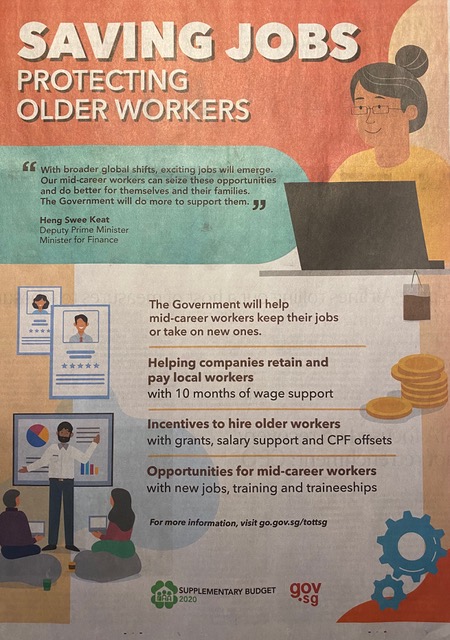
Saving Jobs Advertisement Source: The Sunday Times 7 June, 2020, p, A3
For students whose school year has been interrupted, there is great uncertainty, particularly for those in their final year of high school or University. We cannot but feel sorrow for the ruin of their graduation ceremonies and summer plans, which should be the most memorable of their lives – being with the friends and classmates they grew up with, sharing their plans for the future, saying farewell and making promises.
For young love to be deprived of the pleasure of being together with their boyfriends and girlfriends is sad indeed. A young man lamented to me, “I wish they would allow us to see just one other person.” We all know who that one other person is.
The overwhelming question is the future. Will they be able to attend/return to universities? Or will they go online? Senior academics of leading tertiary institutions here seem to imply that there will be a return to physical classrooms, “as education is a social process” (Davies, 2020). What jobs await fresh graduates? What do they have to look forward to? No one has the answers; everything is in an unsettling state of limbo. Meanwhile fresh graduates are putting aside their dreams and taking work where they can, while scaling up their skillset (Teng, 2020).
The Novelist Meira Chand, used the phrase “a plague of Biblical proportions,” in a personal conversation on COVID-19 in early February. Now it has become a catchphrase for all the events – natural disasters and political events – around the globe that have caused distress and fear and changed the global socio-economic landscape. There are three international flash points that have had an effect on Singapore: India, Hong Kong and the US.
The pandemic has exposed political and social fault lines in both India and the US, two countries that are intimately tied to Singapore, in several unforeseen ways. These weaknesses of Singapore’s political and economic allies are coupled with unprecedented natural disasters and severely testing the assumed stability of the pre-pandemic world-order. This puts at risk Singapore’s food security which imports 90% of food supplies.
Furthermore, the blame-game between the US and China as to who started COVID-19 and their spat regarding trade, has repercussions for the global economy. Hong Kong, the former British colony, has become the flashpoint. Protests demanding greater political participation have led China to pass a National Security Act to control the territory. Widely criticized by the West, Hong Kong has become another bone of contention between the two dominant powers of the west and east.
The ratcheting up of tensions between these superpowers is very worrying for South-east Asia and particularly for Singapore which has to tread a fine line between the two, stretching diplomacy due to strategic economic and political ties (Lee, 2020).
In light of these developments, the Singapore government has begun a “30 by 30” campaign with the goal to produce at least 30% of its own food by 2030. As a first step, citizens are being encouraged to grow their own vegetables at home in planter beds on their balconies or in community gardens, through an NParks initiative that is supplying two types of seeds free to residents who register for them (Begum, 2020). Vertical city farms and hydroponic produce are now being encouraged even more than before.
All Zoomed Out
One of the effects of the pandemic has been a shift to using new technologies to continue with our work routines. With a number of different technologies available, one’s working day is full of appointments on Zoom, Webex, Webinars, Facebook Live, IGTV Live, old-fashioned phone calls, SMS messages, WhatsApp messages, and a host of other communication platforms. These could be meetings, talks, online classes (including for children), seminars, roundtables, board meetings or conversations. After work, if home and work lines are not blurred, there’s Vimeo, YouTube, Hulu, Tubi, Starz, Disney, in addition to Netflix, Apple TV, Amazon Prime, amidst a host of many more, for home entertainment. While the CB is an opportunity to learn to interact on these various platforms, it is also exhausting. To keep a distinction between the home and work space, both physically and mentally, requires discipline. When do you relax, and when do you work? It is important to maintain this healthy difference.
Among the new technologies practiced during the ongoing pandemic is the optional use of a contact tracing app. Those using the app, reportedly one-fifth of the population, agree it is crucial to ring-fence infections. Despite critics’ worry about privacy, the authorities are preparing to introduce a wearable device to be distributed free to all. In view of greater movement of people with the lifting of the CB, the authorities say it will be more inclusive, ensuring protection for all (Mahmud, 2020).
Conclusion
Across the globe, shutting down of human activity has resulted in bluer skies, clearer waters, and the return of birds and other creatures in cities. People have had the time to stop and appreciate our impact on the planet. It is unclear when this pandemic will end, and how the world economy will revive. Will the new normal mean we are all confined to our homes, or will we return to mingle in the workplace and live with the risks of infection? The involuntary experiment of shutting offices has led many businesses to realize they do not need large expensive premises and working from home is a viable alternative, especially for workers who need to be home to care for children or the elderly. This will certainly alter the landlord-tenant dynamic, and businesses will be more streamlined, offering workers greater flexibility. Will new technologies aid us or become surveillance tools? Will the experience with migrant workers lead to better living and working conditions for them?
The “GE will chart Singapore’s direction for the next decade,” says DPM Heng (Heng, 2020). Rather than wait and watch, Singapore citizens now have the chance to redefine their world by voting and participating in community feedback calls to ideate Singapore’s post-COVID reality. It is for them to decide what to trade-off for bluer skies.
22 June, 2020
References
- Begum, Shabana. “More community plots sprouting up to cater to gardening enthusiasts,” The Straits Times, June 19, 2020, HOME, p. B1.
- Cheong, Danson. “‘Prioritising common good’ helping Asia fight virus,” The Straits Times, June 20, 2020, WORLD, p. A16.
- Choo, Yun Ting. “Tripartite trust can help S’pore weather virus storm: Ng Chee Meng,” The Straits Times, June 12, 2020, p. A8.
- Choo, Yun Ting. “Every effort being made to ensure no ‘lost generation’,” The Straits Times, June 11, 2020a, p. A1.
- Davies, Sandra. “How the pandemic will change universities,” ST-SMU Reimagining Universities Education Forum, The Straits Times, June 22, 2020, p. B7.
- Goh, Yan Han. “400,000 households to get $50 vouchers to spend at local businesses,” The Straits Times, June 13, 2020, p. A4.
- Goh, Yan Han. “Sisters create website to help those in need,” The Straits Times, Home, June 15, 2020a, p. B2.
- “Helpline Updates,” AWARE e-newsletter, https://mailchi.mp/aware/aware-updates-may-2020, May 12, 2020. (Accessed 1 July, 2020)
- DPM Heng, Swee Keat quoted in The Straits Times (ST), June 9, 2020, p. A1, see also A6&7.
- Ho, Grace. “President Halimah gives assent to additional $33b in support packages,” The Straits Times (ST), June 17, 2020a, p. A3.
- Ho, Grace. “No mid-year bonus for civil servants; pay cuts for senior officers,” The Straits Times, June 19, 2020b, p. A1.
- Ho, Grace. “Public service stands with the rest of the nation to face tough times: Chan,” The Straits Times, June 19, 2020c, p. A11.
- Ho, Grace. “S’pore to strengthen social compact to keep society united,” The Straits Times, June 18, 2020d, p. A1.
- Hui, Mary. “The Singaporean government is taking a collective pay cut out of coronavirus solidarity,” https://qz.com/1810072/singapore-government-takes-pay-cut-due-to-coronavirus/ 28 February, 2020 (Accessed 22 June, 2020)
- Iau, Jean. “Coronavirus: More cases of family violence during circuit breaker; police to proactively help victims,” The Straits Times, https://www.straitstimes.com/singapore/courts-crime/coronavirus-more-cases-of-family-violence-during-circuit-breaker-police-to. 20 May, 2020 (Accessed 4 June, 2020)
- Lai, Linette. “Virus may be here for the long haul so Singapore must adapt: Minister,” The Straits Times, June 10, 2020, p. A1.
- Lee Hsien Loong. “The endangered Asian century, America, China and the perils of confrontation,” Foreign Affairs, https://www.foreignaffairs.com/articles/asia/2020-06-04/lee-hsien-loong-endangered-asian-century 4 June, 2020. (Accessed 5 June, 2020).
- Lee, Vanessa. “Kids enjoy quality time at home,” The Sunday Times, Life Features, June 8, 2010, p. C8.
- Mahmud, Aqil Haziq. “COVID-19: Govt developing wearable contact tracing device, may be distributed to everyone in Singapore,” https://www.channelnewsasia.com/news/singapore/COVID-19-contact-tracing-device-trace-together-app-12806842, 5 June, 2020. (Accessed 5 June, 2020)
- Menon, Malvika (comp.). “5 Things to do today,” The Straits Times, June 16, 2020, life, pp. C2 & 3.
- Ministry of Finance (FOM). Singapore Budget 2020, Solidarity Payment, https://www.singaporebudget.gov.sg/budget_2020/solidarity-budget/solidarity-budget-statement (Accessed 19 June, 2020)
- Phua, Rachel & Ang, Hwee Min. “COVID-19: Worries about pandemic see more calls to mental health helplines,” Channel News Asia (CNA), https://www.channelnewsasia.com/news/singapore/COVID-19-fear-toll-mental-health-hotline-anxiety-singapore-12631710. 15 April, 2020 (Accessed 4 June, 2020)
- Ratcliffe, Rebecca. “’We’re in a prison’: Singapore’s migrant workers suffer as COVID-19 surges back,” The Guardian, https://www.theguardian.com/world/2020/apr/23/singapore-million-migrant-workers-suffer-as-COVID-19-surges-back. 23 April, 2020 (Accessed 5 June, 2020)
- Rekhi, Shefali. “Trust in governments surges during pandemic, survey shows,” The Straits Times , June 22, 2020, WORLD, p. A9.
- Rekhi, Shefali. “Trust in Singapore Government up: Edelman poll,” The Straits Times , June 22, 2020, WORLD, p. A9.
- Stack, Meghan. “A sudden Corona virus surge brought out Singapore’s dark side,” The New York Times, https://www.nytimes.com/2020/05/20/magazine/singapore-coronavirus.html, 20 May (Accessed 5 June, 2020).
- Tan, Theresa. “More calls to govt helpline for seniors, carers during circuit breaker,” The Straits Times, June 5, 2020, HOME, p. B6.
- Teng, Amelia. “What lies ahead for the Class of Covid-19?” The Straits Times, June 7, 2020, Insight, p. B4.
- Teo, Chee Hean. “The 3 keys to a more resilient Singapore,” The Straits Times, June 12, 2020, Opinion, p. A21.
- Tham, Irene. “Jobs for many Singaporeans growing in the infocomm sector,” The Straits Times, June 22, 2020, p. A1.
- Tham, Yuen-C. “PM, ministers to speak on post-Covid future,” The Sunday Times, June 7, 2020, A3.
- Tham, Yuen-C. “DPM spells out plans for S’pore to emerge stronger after crisis,” The Sunday Times, June 21, 2020a, A1.
- “How Corona Virus is spreading across the world.” The Straits Times, https://www.straitstimes.com/multimedia/graphics/2020/02/wuhan-virus-numbers/index.html 20 June (Accessed 20 June, 2020).
- “President gives nod for $33b in relief measures.” The Straits Times, June 17, 2020, p. A1.
Coonoor Kripalani is a writer and researcher living in Singapore. Her publications in international journals have primarily focused on popular Hindi (Bollywood) film and radio broadcasting in India, her current topic of research. Coonoor is the author of a succinct biography, Mahatma Gandhi: Apostle of Non-violence (New Delhi, India: Rupa & Co., 2003) as well as co-editor of Indian and Chinese Immigrant Communities: Comparative Perspectives (London & NY: Anthem Press & Singapore: ISEAS, March 2015). Coonoor also writes bilingual books in Hindi and English, for children.
Citation
Coonoor Kripalani. 2020. “COVID Reflections: A View from Singapore” CSEAS NEWSLETTER, 78: TBC.

